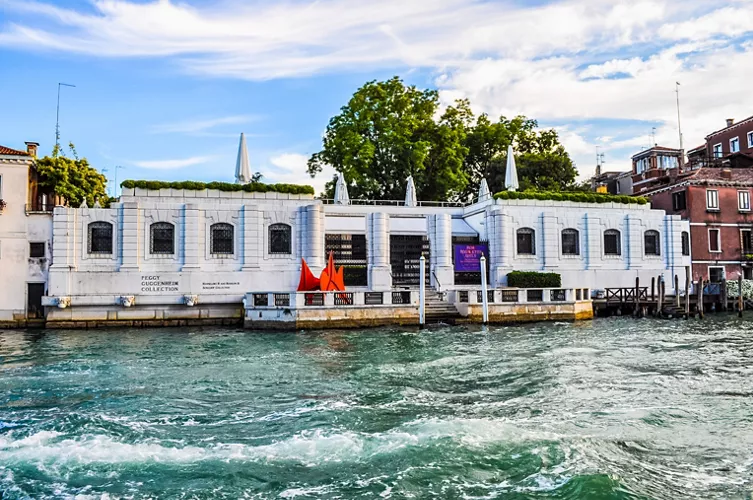This content was automatically translated. View the original text.

Overview
The Peggy Guggenheim Museum in Venice is located in a house on the Grand Canal where the American art dealer and collector lived after World War II, displaying one of the most important collections of 20th century European and American artists in Italy.
A lover of avant-garde, Guggenheim acquired works by Cubists, Futurists, Surrealist Dadaists, American Modernists and Italian Abstract artists throughout her life.
And today the Guggenheim Foundation carries on Peggy's dream in her extraordinary house-museum.
What to see at the Peggy Guggenheim Museum
The Peggy Guggenheim Collection (1898-1979) is located on the Grand Canal in Venice between the Accademia Bridge and the Basilica of Santa Maria della Salute, in the only single-storey white Istrian stone building, Palazzo Venier dei Leoni.
Left unfinished, Guggenheim bought the building after the war when she fell madly in love with Venice. The art dealer and collector lived in this mansion overflowing with works of art until her death in 1979: when she was still alive, she liked to open her house to the public to show her works once a week for free.
Donated to the Solomon R. Guggenheim Foundation, which also runs the eponymous museums in New York, Bilbao, and Abu Dhabi, today Peggy Guggenheim's collection enriched over time can be visited in the house-museum.
It includes works by Constantin Brancusi, George Braques, Salvador Dali, Max Ernst (one of Guggenheim's husbands), Vassily Kandinsky, René Magritte, Pablo Picasso and Jackson Pollock, among others.
The creators of abstract art include the Italians Afro, Carla Accardi, Agostino Bonalumi, Pietro Consagra, Lucio Fontana, Giuseppe Santomaso, Toti Scialoja and Emilio Vedova.
In addition to the permanent collection in the house-museum, various exhibitions of contemporary artists can also be visited.
The Schulhof and Nasher Collections
In 2012, the museum was enriched with 83 works from the collection donated by the American couple Hannelore and Rudolph Schulhof, including various 20th-century artists like Alberto Burri, Alexander Calder, Jasper Johns, Mark Rothko and Claes Oldenburg, in addition to Andy Warhol, Sol LeWitt and Anish Kapoor.
A new building was purchased to accommodate the acquired works in 2016, now also home to introductory art activities for schools and families, as well as an international internship programme dedicated to young art enthusiasts.
The garden instead displays sculptures from the Nasher Foundation permanent collection with pieces by Hans Arp, Alberto Giacometti, Piero Gilardi, Marino Marini, Luciano Minguzzi, Mirko, Henry Moore, Mimmo Paladino, Germaine Richier and Takis.
The woman who bought a painting a day
"My motto was Buy a painting a day and I followed it to the letter”. This was Peggy Guggenheim, the American heiress whose love of art was commensurate with her immense fortune inherited from her father Benjamin, a mining magnate who died in the sinking of the Titanic.
Growing up in New York, she and her first husband frequented the Parisian art scene in the 1920s, befriending artists such as Brancusi and Duchamp. In 1938 she opened an art gallery in London (Guggenheim Jeune) where she showed Kandinsky's first solo exhibition in Great Britain and presented artists such as Tanguy, Cocteau and Kernn-Larsen. In those years she bought her first work, a sculpture by Hans Arp, and developed the idea of creating a museum of modern art in London, which the outbreak of war prohibited: in those difficult years, however, she managed to acquire a large number of important works.
Back in New York, in 1942 Peggy opened the gallery-museum Art of this Century with the first core of her collection and exhibitions of emerging artists, such as the first solo show of Pollock, of whom she was a patron.
She moved to Venice in 1947. The following year she exhibited her collection at the Biennale and in 1950 she brought Pollock to Europe for the first time, in an exhibition held in the Napoleon Wing of the Correr Museum in St Mark’s Square. As early as 1951 she began to open her house to the public, albeit occasionally, so that everyone could, like her, enjoy art.
Guggenheim is buried in the garden of the Venetian house-museum, together with her dogs.
For more info visit the website: https://www.guggenheim-venice.it/en/visit/
For more info visit the website: https://www.guggenheim-venice.it/en/visit/